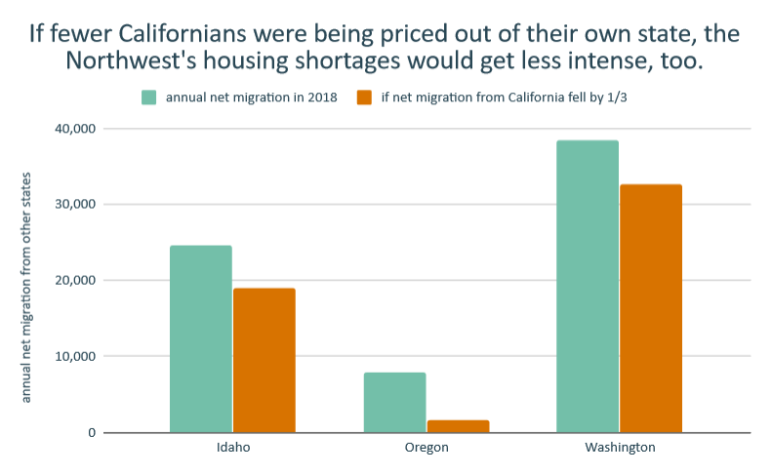California’s repeated failure to strike down local bans on close-in housing has an incalculable number of victims. But 13 million of them live in Oregon, Washington, and Idaho.
Year after year, through booms and busts, California sends a one-way jet stream of people moving north to Cascadia. If comparable numbers of people were instead able to flow in both directions, those Northwest states would find it much easier to build enough homes to keep up with population growth.
That’s especially true in Oregon, which gets one of the nation’s most lopsided inflows of people from California. If net migration out of California were to drop by 33 percent across the board, Oregon’s overall net population growth from domestic migration would fall about 80 percent.
California cities aren’t the only ones whose invisible walls of exclusionary zoning have created a housing shortage that spills across state lines. But California’s effects on Cascadia show why the collective failure of local governments to allow housing can demand national action.

Last week, as California’s fourth consecutive year of extreme wildfires forced another round of evacuations from its ever-sprawling exurbs, California’s legislature rejected yet another bill that could have dramatically reduced the state’s shortage of homes.
Senate Bill 1120 would have legalized duplexes on almost any owner-occupied urban residential lot in California and—maybe even more importantly—allowed the same lots to be split in half. That’d essentially allow up to four homes on most such lots. (Lots currently or recently occupied by tenants could have been developed too, as long as the tenant-occupied home wasn’t removed.)
Re-legalizing these small-scale options across the most housing-scarce US state could have added up to big results. A July study from UCLA had estimated that broad fourplex legalization would make it financially feasible to add 1.2 million more homes to California—about half of the frequently cited estimate of the state’s chronic shortage, 2 to 3.5 million homes.
Californians, most of whom seem to favor housing legalization and who are blessed with a persistent and creative squad of vehemently pro-housing organizers and lawmakers, have every reason to be upset. But so do many millions of people outside the state—maybe more than anyone else, those of us in Cascadia.
Many former Californians seem to be fleeing home prices

Every year, more than 100,000 people migrate from California to the three states that might be most similar to it: its three closest neighbors in the Pacific Northwest.
It’d be a perfectly healthy flow of people and their ideas if a comparable number of people were moving the other way, too. But these days, 60 years after California’s last big population boom, that’s not how things work. Only half as many people—just over 50,000 in 2018, according to the Census Bureau—move to California from Oregon, Washington, and Idaho.
Who are these people migrating from California? Many are, of course, moving for work, school, or family. Others may be fleeing California’s worsening climate, or maybe even its politics. But data suggest that many are home price refugees. In Oregon, and to a lesser extent in Idaho and Washington, migration from California is concentrated among lower-income and younger people.
And who could blame them? California’s home prices are bonkers, and only getting higher.
One in five rentals in the state goes for more than $2,000 a month. The median owner-occupied home costs $546,800. Of the nation’s 10 least affordable metro areas by ratio of median home price to income, seven are in California. (So is the 11th: Fresno, whose sprawling suburbs are facing an “unprecedented disaster” this week from the Creek Fire.)
This is what it looks like when most of an entire state stops building anywhere close to enough homes for year after year. It creates a cruel game of musical chairs. With too few chairs, everyone ends up paying dearly, but the richest are always the ones who get to sit down first.
The poorest, meanwhile, end up living on the street or hitting the road. Or they might still be stuck at home in Baton Rouge or Bangkok, unable to relocate to a place where a better life might await them if only the first and last month’s rent weren’t inconceivably expensive.
The federal government could do something
When a state problem spills across a state’s borders—or, in the case of California land use, thousands of local problems do—it’s time for the federal government to see what it can do.
There are legitimate reasons for the federal government to tread lightly. Housing reforms that would work in San Jose may not work in St. Joseph, Missouri. But there are also reforms that make sense anywhere, like re-legalizing smallplexes and making driveways optional.
In an age when domestic migration has fallen to economically dangerous lows, when exclusionary zoning is a crucial force behind the 30-year re-segregation of American schools, and when Gulf hurricanes are sucking wildfire smoke all the way across the Great Plains, national leaders should get to work figuring out what they can agree on.
As I wrote last year, there’s been a rapid shift in the national politics of housing abundance. As my colleague Dan wrote last week, there are already good bills in Congress. Congress could incentivize states to pass laws like Oregon has, or directly reward cities and counties that allow more homes. Local advocates have been floating data-driven methods for identifying exclusionary neighborhoods that could be built into laws, administrative rules or judicial review.
What’s missing, so far, is a chance for Congress to vote.

